It is not one world, culturally or economically. For many in the developing world, indoor air pollution comes from the open fires and solid fuels they use to cook. In addition to possible health risks, not all solid fuels are ecologically sustainable, and if you have to spend the part of the day searching for fuel, there is less time for other necessary activity. As you might anticipate, where you live, rural or urban, can be as impactful as the country under discussion.
In India, policymakers felt that the major impediment to the rural use of liquefied petroleum gas (LPG), a cheap alternative, was the initial capital outlay to convert stoves. A program to provide the stoves at no cost was taking advantage of by 70 million households. The only ongoing cost was the LPG cylinders.
The free stoves rapidly increased customers, although there was a drop in the recruitment of new customers not receiving the stoves. The researchers felt that in some cases, consumers who had the means to purchase the system took advantage of the moment and found ways to get in on the free stove program. The economic term for these individuals is “free-riders.” [1] If that were true, then stove uptake stimulated by the program would be overestimated. The other factor at play, according to the researchers was a “wait and see” attitude of those on the cusp of being eligible; if they would just wait, the program would expand, and they could get the free stove rather than spend their limited funds now.
When the researchers looked at tank refills, as a measure of use, they found that both the regular consumer as well as those with the free stoves purchased significantly less fuel than urban-based utilizers. Moreover, the families with the free stoves used even less, half as much, LPG than their counterparts who could afford the stoves themselves. And this doesn’t seem to be just a short-term problem, as people incorporate LPG use into their domestic workflows.
Of course, part of the issue is that poor people who can’t afford stoves often cannot afford LPG, but that doesn’t account for the lack of increased use by those customers who could afford stoves. The researchers indicated that LPG prices were stable, so economics cannot entirely explain the lack of change.
What more generalized conclusions can we make? Access is necessary but insufficient. They had the stoves; they just didn’t use them. And in many instances, the reason was that they either could not afford the fuel or that some other habit kept them in their current pattern of behavior. Fixing one aspect of an extended supply change is no guarantee that your result will be what you anticipated.
Given my physician lens, it is easy enough to generalize the same problem to healthcare where again, access is necessary but not sufficient. You have to be able to afford the prescribed therapy, so increased access has to come with subsidized medications. And old habits are difficult to change, many patients with greater access still utilize high-cost Emergency Departments rather than lower-cost physician offices – the former requires far little planning on the patients part.
[1] Please do not think of free-riders as necessarily a pejorative term. Your children are free-riders on your health plan, at least till age 26.
Source: Using sales data to assess cooking gas adoption and the impact of India’s Ujiwala program in rural Karnataka Nature Energy DOI: 10.1038/s41560-019-0429-8




